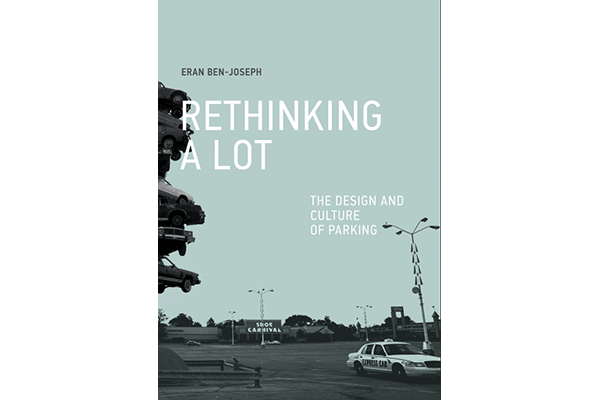
Author: Eran Ben-Joseph (MIT Press, 2015)
Surface parking lots are ever-present in the contemporary city. Moovelab’s incredible visualization project What the Street!? that inventoried parking lots in 23 cities around the world found, for example, that car parking takes up 17,020,594 square meters of land in Los Angeles—roughly 1/6th the area of Vancouver. In fact, in 2010, it was estimated that 500 million surface parking lots exist in America alone. A number that has surely increased since then.
Given their pervasiveness, surface parking lots play a large part in the experience of the city, influencing multiple facets of everyday life. Moreover, their asphalt-dominated surfaces have large ecological impacts. This being the case, it’s amazing how little thought or discussion goes into these prevalent urban environments. In real terms, even a small recalibration of surface parking lots can have large consequences on the workings of the built and natural worlds. In order to intervene, however, a better understanding of the surface lot—culturally, environmentally and economically—is required. This is the motivation behind Rethinking A Lot: The Design and Culture of Parking. Written by Eran Ben-Joseph—head of MIT’s Urban Studies and Planning Department and author of two other excellent, somewhat related books, Streets and the Shaping of Towns and Cities and The Code of the City: Standards and the Hidden Language of Place Making—the book has humble intentions:
…not to champion the abolition of surface parking lots or to advocate the creation of strict codes and standards that dictate their design, but rather to illustrate their ongoing contemporary effects on our life and their great potential for the future.
And this it does, with wit and grace. Its humourous play on words is not only evident in the book’s clever title, but throughout the book, including the three chapters around which it’s structured—A Lot in Common, Lots of Time and Lots of Excellence—each of which is broken into smaller sections. These, in turn, are further broken down into bite-sized segments, some of which are two paragraphs in length. The result is a very accessible read that is easily referenced. A peppering of wonderful photographs and imagery throughout makes it that much easier to go through.
Following the cleverly named introduction A Lot of My Mind, the first chapter A Lot in Common introduces the parking lot as one of the most common and under appreciated spaces of the contemporary city and describes its social and cultural significance in North America. It also outlines key metrics and standards around their creation as well as the larger effects of parking on the environment (water, energy, etc.) and associated costs.
Lots of Time looks at the interesting history and development of surface parking. Included within is a brief history of curbs and roads, an important discussion around women and their role in the evolution of parking lots, the effects of parking on the morphology of the urban environment, and a critical examination of the history of aesthetics and surface parking lots. Key figures in the growth and regulation of parking—such as William Phelps Eno, “The Father of Parking Rules”—are also introduced, highlighting their contributions to the adaptation of parking lots over time.
The last chapter, Lots of Excellence, is dedicated to demonstrating the potential of surface parking lots. It focuses on its capacity for flexibility and ability to be cultural and social assets for their surrounding communities: exciting spaces of multi-use and complex programming. This is further extended to illustrate how parking lots can also be ecologically beneficial. Naturally, a handful innovative of global precedents are also outlined within. A short conclusion—Musing A Lot—follows the latter and ties things together nicely as a bookend.
Too frequently, the discussion around cities, urban planning and design focuses on the most blatant, visible parts of the urban landscape—overlooking the most ordinary. This is done to detriment of a more comprehensive understanding of the cityscape and its latent possibilities. In providing a wonderfully succinct and readable analysis on one of the most commonplace environments and highlighting its ability to become significant public spaces of aesthetic and ecological value, Eran Ben-Joseph has done urbanist, architects and planners and designers a great service—making Rethinking A Lot a necessary read for those looking to gain a more holistic understanding of the contemporary urban landscape.
***
For more information on Rethinking A Lot: The Design and Culture of Parking, visit the MIT Press website.
**
Erick Villagomez is one of the Editor-in-Chief at Spacing Vancouver. He is also an educator, independent researcher and designer with personal and professional interests in the urban landscapes. His private practice – Metis Design|Build – is an innovative practice dedicated to a collaborative and ecologically responsible approach to the design and construction of places. You can see more of his artwork on his Visual Thoughts Tumblr and follow him on his instagram account: @e_vill1.




